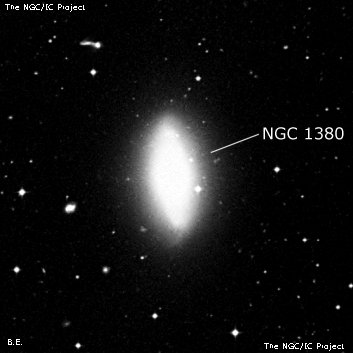
James Dunlop discovered NGC 1380 = D 574 = h2559 on 2 Sep 1826 with his 9" reflector at Parramatta. He recorded "a rather faint pretty well-defined elliptical nebula, about 1' long, and 50" broad, a little brighter to the centre." His position was well off, 19.5' ESE of ESO 358-028 = PGC 13318. John Herschel made a single observation on sweep 635 (19 Oct 1835) and logged, "very bright; large; round; pretty suddenly brighter towards the middle; A fine nebula." He added: "The obs. of the place like that of Dunlop 591 above was lost by setting the instrument on the place given in Mr Dunlop's Catalogue, and relying on his RA (3h 31m) which is too great, instead of sweeping over them, when they could not have escaped being regularly taken." In 1865 Julius Schmidt measured a more accurate position with the 6.2" refractor at the Athens Observatory.
200/250mm - 8" (10/13/81): fairly bright, moderately large, elongated, bright core.
300/350mm - 13.1" (12/22/84): very bright, elongated 2:1 N-S, bright core, faint elongated halo. A very faint mag 14 star is SW of the core 1.2' from the center. Member of Fornax I cluster.
400/500mm - 18" (12/17/11): extremely bright, large, elongated ~5:3 N-S, ~3.0'x1.8'. Sharply concentrated with an intense, elongated core that brightens to the center, though there was no evident nucleus. A mag 13.5 star is superimposed ~0.9' SW of center. This is one of the brightest Fornax cluster galaxies.
Notes by Steve Gottlieb